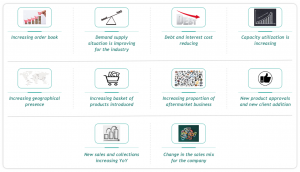The joys of investing in small cap space is that the universe is wider which makes us learn and understand businesses across a vast spectrum. Secondly there is greater formalization among various businesses which is going to benefit a lot of small cap companies. The formalization is being hastened by regulatory changes like GST, RERA and focus of government on increased adoption of digital payments. Provided the choice is better, the chances of making higher returns over a longer period of time increases.
However, with chances of higher returns there are also larger pitfalls to investing in small cap:
- Small cap companies are more volatile,
- The chances of failure are higher among early stage companies
- Liquidity crunch can be there for small cap companies during difficult times
- Stocks are less liquid
- Management’s commitment is less known
- Not widely tracked and hence higher level of information asymmetry
The way we manage these pitfalls in Special Situations Portfolio, where the mandate is to invest in mid and small cap companies with improving growth prospects, which can lead to significant improvement in company’s financials is by:
Focusing on business: The most important ingredient for any successful investment is how thoroughly we understand the business. For us an attempt to understanding of a business means having a fair understanding of the business model, nature of competitors in the industry, challenges the industry has faced and the possible future headwinds, can the challenges be so severe that a company with long history is not able to survive the headwinds, is there scope to grow profitably for long period of time, what are the company’s plans for sustainable profitable growth, is the business self-sustaining in terms of capital requirements or will depend on external funding, how often will external funding be required, does the company differentiates itself in the marketplace through its brand, product offerings, service standards, geographical footprint, or cost of production etc., is the culture of the organization entrepreneurial but still of prudent risk taking, is it a learning organization or keeps on doing same mistake often etc..
Focusing on early stage of improvement: Over a period of time we have observed that operating parameters tend to improve before a visible improvement is there in the P&L, Balance Sheet and cash flows of a company. Building conviction early has helped us in buying business at cheaper valuations. Once there is a visible improvement in financials of the company chances of being able to buy with high margin of safety are low.
Below mentioned operating parameters have historically helped us in building an early conviction in a company.

Understanding of historical financials: The first requirement for growth is to survive for long period of time. Good understanding of long term historical financials gives an understanding of type of business challenges they have faced and how threatening were such situations for the financial well-being of a company.
The other two aspects we closely follow are: avoiding companies having debt: equity more than 0.5 and credit rating below BB. The risk is on the bad days the company may not be able to roll over the debt it has or is not able to raise incremental debt requirement in tough markets.
Focus on the promoter’s skin in the game: Promoters should have less than 50% of shares which are pledged. We take high % of shares pledged by the promoters as a distress on the promoter’s financial situation which can make promoters do something which is not in outside investors best interest.
Companies which have a listed history of less than 10 years: During the process of research our focus area is to understand how the management has reacted over a long period of time in various situations and how has the business evolved over a period of time. Hence a listed history has been quite helpful for us to understand businesses.
Following this process of buying companies early into their growth phase; has helped us to build a portfolio which has low overlap with other small cap focused products available in the market (since the inception of SSP our average overlap with other small cap MF schemes has been less than 5%) and hence it gives a good diversification to the investors.


